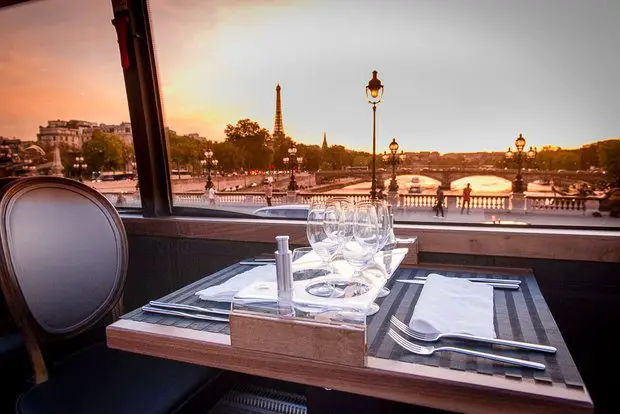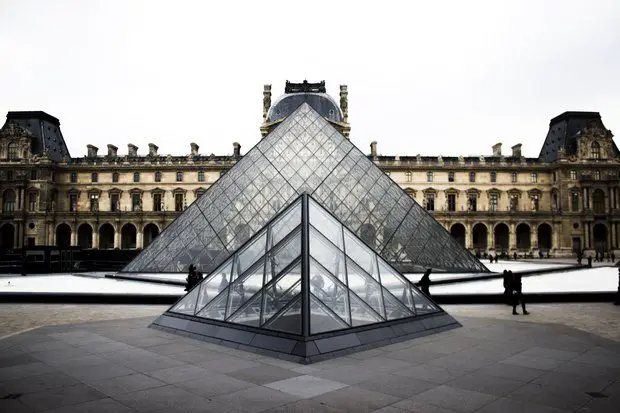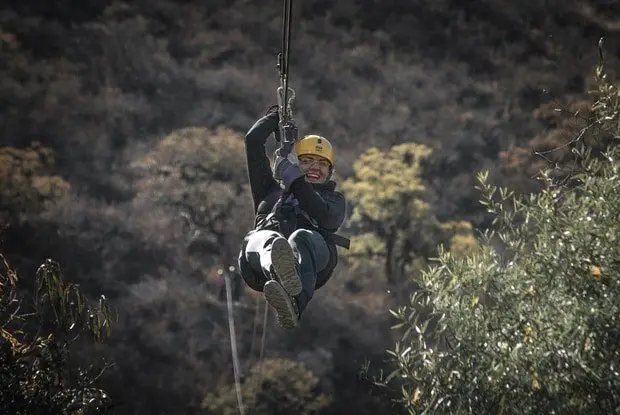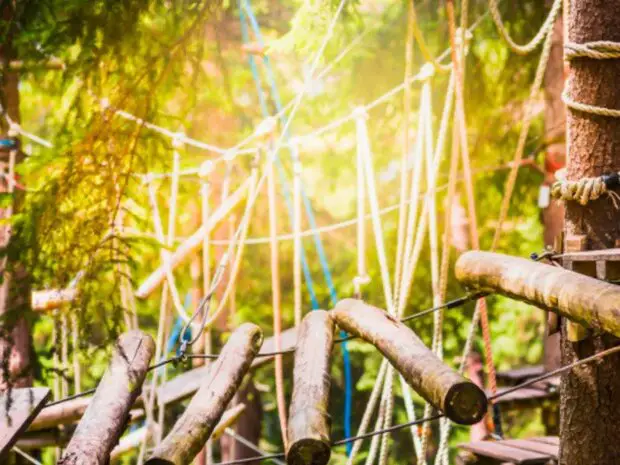Ready to explore Fontainebleau, one of France’s cultural highlights? Whether you’re just looking for a fun getaway or aiming to learn something about its famous castle, follow this guide!
With my tips, your one-day trip from Paris to Fontainebleau will leave you with unforgettable memories of the castle’s many treasures.
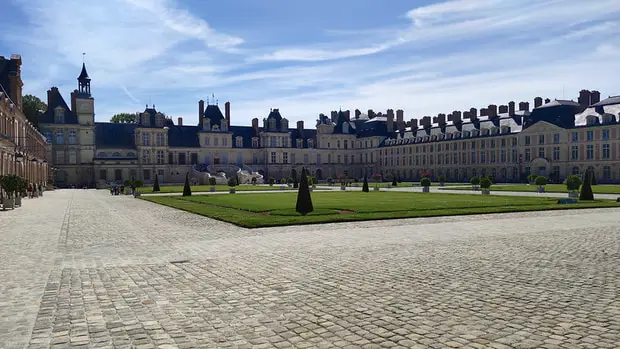
Table of Contents
How to Get to Fontainebleau?
By Car
Fontainebleau’s castle is a one-hour drive from Paris, excluding traffic jams.
Take the A6 (Porte d’Orléans or Porte d’Italie) then the Fontainebleau exit.
Next, head towards Fontainebleau and follow the signs for the “château” until you arrive at Place General Charles de Gaulle.
There is a private parking lot where you can leave your car for €21.20 a day.
For free parking, you have to go further away from the castle. Both of the following locations are open seven days a week.
- Lagorsse Parking at a 22 minutes walk, 4 Bd Crevat Durant.
- La Faisanderie, at 14 min, Route de l’Ermitage.
By Train
Fontainebleau is a 45-minute train ride from Paris, with one train running every two hours.
To go there, hop on the Transilien (TER) Line R from Paris Gare de Lyon to Montargis, and get off at Fontainebleau-Avon. From here, it’s a 20-minute bus ride to the castle or a 35-minute walk if you want to burn some calories.
You could also book a cab for €28. (French website.)
If you’re neither keen on walking nor calling a cab, get on the Line 1 bus direction Les Lilas and get off at Château. It’s a €7.50 trip: €5 for the train ticket and €2.50 for the bus.
There is a bus roughly every 15 minutes on weekdays and every half hour on Sundays. Counting the train ride (45min) and the bus (20min) it should take you around 1h05 to reach your destination.
Hours and Prices
Opening Days and Hours
The castle is open every day of the year except Tuesdays, the first of January and May, and December 25th.
- 9:30 a.m.-5 p.m. from October to March. Final admission: 4:15 p.m.
- 9:30 a.m.-6 p.m. from April to September. Final admission: 5:15 p.m.
The park and the garden are open every day and freely accessible:
- 9:00 a.m.-5 p.m. (last entry 4:00 p.m.) from November to February
- 9:00 a.m.—6:00 p.m. (final admission 5:00 p.m.) in March, April, and October
- 9:00 a.m.—7:00 p.m. (final admission 6:00 p.m.), from May to September
Diana’s garden closes 30 min earlier than the indicated time. The English garden, one hour.
Prices
A €13 ticket will give you access to the Napoleon I Museum and the Grand Appartements. I strongly recommend purchasing your tickets in advance.
Things to know:
- The castle is freely accessible on the first Sunday of each month except July and August.
- A video guide is available upon request for €4. Fair warning, the stocks are limited. The guide comes in 11 languages: French, English, Spanish, German, Italian, Portuguese, Japanese, Russian, Chinese, Dutch, and Polish.
- An elevator leading to the Grand Apartments is available to guests with reduced mobility.
My advice: If you’re like me, and this is your first visit, you’ll want to do as much as possible in your limited time. In that case, you should try the guided tour: “une journée au château”.
The entry ticket only gives access to Napoleon I Museum and the Grand Appartements. To explore the remaining rooms of the castle, you need a guided tour. Each one costs €19.
So, if you also want to see the Imperial Theater, you’ll have to add a €19 guided tour to the entry ticket’s price. And more of the same if you want to see other areas of the castle excluded from the circuit covered by an entry ticket.
With “une journée au château” you can access 3 guided tours for €33.
Unless you prefer to restrain your visit to the gardens, the Napoleon I Museum, and the Grand Appartements, this is the most affordable way to see as much as possible of the castle’s halls in one trip.
Free Admissions and Reduced Rates
Upon presentation of the appropriate documents, some visitors can benefit from free admissions or reduced rates. For example:
- People under 18 years old
- UE residents between 18 and 26 years old
- Job seekers
- Disabled people and their aides . . .
How Long Does it Take to Visit Fontainebleau’s Castle?
A complete tour of Fontainebleau’s castle takes two or three hours, one for the gardens and two for the castle’s halls.
If you want to avoid running out of time, it’s best to arrive before 3 p.m.
While the length of the guided tours can vary, none exceed two hours.
When to Visit Fontainebleau’s Castle?
There are at least two factors to consider for a visit to Fontainebleau’s castle: the weather and the crowd.
In that regard, I recommend a springtime trip in May or April to avoid the peak period of the summer holidays. In July and August, tourists are flooding the place, and the high temperatures can also be an issue.
September’s weather tends to be agreeable, so that can be a good time for a visit.
Come in the morning if you want to waste as little time as possible. It’s pretty quiet around 10 or 11 a.m., and you have good odds of avoiding any ticket lines.
Better to avoid the weekend because it is always more crowded.
Must-Sees: What to See in Fontainebleau?
The Park and Gardens
Fontainebleau’s castle sits at the heart of a 321 acres estate composed of a park and three gardens scattered with statues. And, to the great delight of its visitors, it boasts a 1,200 m canal, whose inviting banks are perfect for leisure strolls.
There is no lack of treasures to uncover here.
South of the castle, visitors can find the Grand Parterre. We owe this marvel of symmetry designed to Andre Le Notre and Louis Le Vaul. Don’t miss the blue-green checkerboard pattern of its square pool and the surrounding flower beds. Or its central fountain, which they call the boiling pot.
Voir cette publication sur Instagram
West of the Carp Pond, the English Garden is a web of narrow paths and sinuous tracks intertwined around an artificial river, where you can enjoy a picnic in peace.
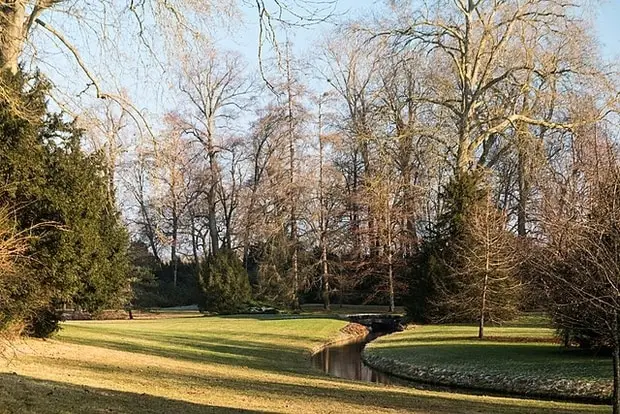
North of the castle, there is Diana’s Garden and its famous statue of the Roman goddess of the hunt. It’s an enchanting place, full of roses, magnolias, and peonies.
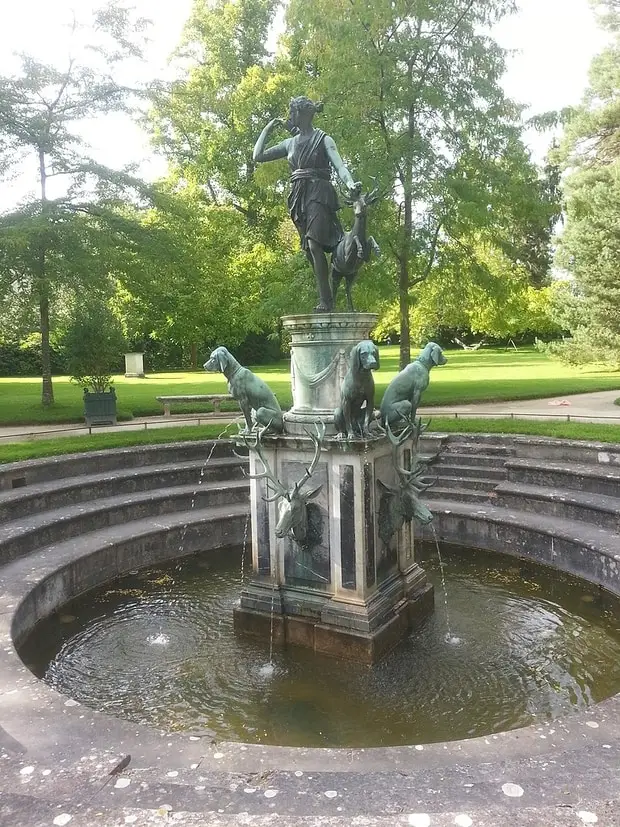
Last but not least, there is also the “Pines’ Grotto” an artificial cave built in the right wing of the castle. The stone giants sculpted in its frame are very much worth seeing.
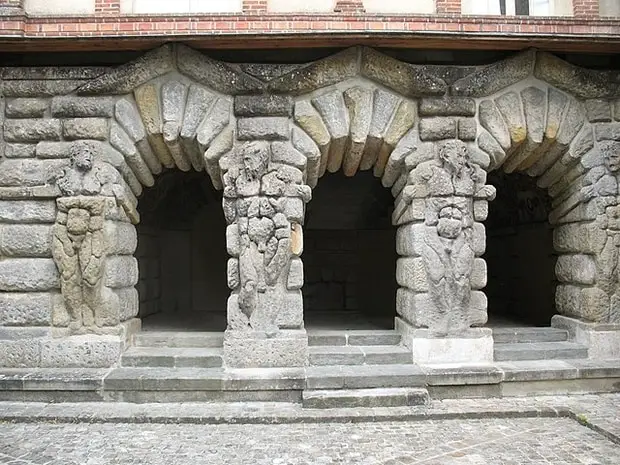
Walking is only the most straightforward way to explore the park and the gardens. Here are some other :
- You can board the little tourist train departing every hour from the Cour d’Honneur, for a 35m ride in the estate. Visitors can buy an €8 ticket for a 5 km journey every day from April to November. The ride is free for children under 4, and anyone between 4 and 18s can get a ticket at half price. You can buy tickets in advance online or onsite.
- Another option is to take a carriage ride. For €7.50 (or €5 for children), you can get on an old-fashioned coach pulled by two horses and explore the place as the royals it hosted did. Information and booking (website in French)
- Finally, you can do some boating on the Carp Pond, every day from May to August. It’s €5 for a 30 m turn on the water, €8 for an hour. Information and booking
Now that we’ve covered the gardens and the park let’s go back to the star of the show: Fontainebleau’s castle and its hidden gems.
The Horseshoe Staircase
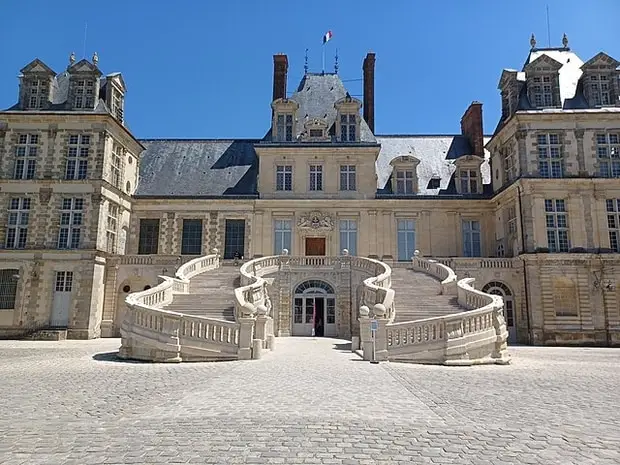
Freshly restored to its original glory, the parallel flights of stairs that greet visitors entering Fontainebleau’s main courtyard are a sight to behold. Shaped like a horseshoe, the gleaming white sandstone of the staircase leading to the castle’s first floor is an architectural wonder.
If you want a keepsake to remember it by and you have a sweet tooth, I recommend the Suzy and Arlette bakery at 95 Rue Grande, 77300 Fontainebleau.
They make a marvelous chocolate cake shaped like the horseshoe staircase called “Les Marches du château” or the castle’s stairs.
The shop is only a 10 min walk from the castle.
Francis I Gallery
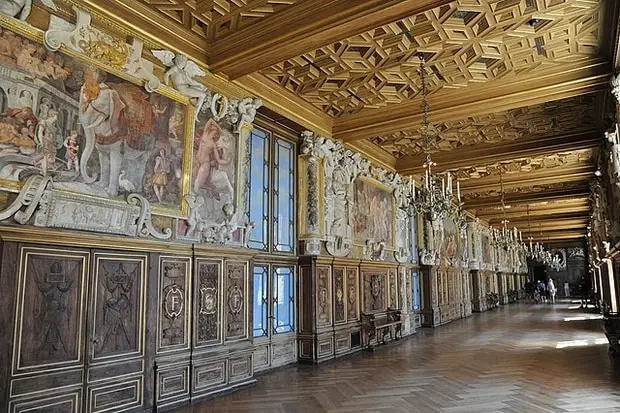
No true art lovers can remain unmoved by the splendid frescoes and paintings adorning the Francis I Gallery. Every inch of its walls is a testimony to the creativity and talent of Renaissance artists such as the Florentine painter Rosso Fiorentino.
Between us, among all the brilliant artwork on display, I found one piece particularly striking. With its coat covered in lilies and the salamander on its brow, there is something quite peculiar and captivating about the Royal Elephant.
Imperial Theater
Voir cette publication sur Instagram
Prepare to be dazzled by one of the most impressive rooms of the Fontainebleau’s palace. When its chandeliers’ light shines upon its gilded walls and the yellow silk of its upholstery, Napoleon III’s theater is bathed in a sumptuous golden glow.
Don’t miss the fresco drawn on the ceiling. Or the Empress’s Foyer, its blue silk walls are charming.
The Royal Chapel of the Trinity
Voir cette publication sur Instagram
With its marble floor and the extraordinary frescoes adorning its vault, the Trinity Chapel is a feast for the eyes. You’d have to be made of stone to stay unmoved by its beauty.
Diana’s Gallery

When thinking about a room dedicated to the goddess of the hunt, you expect to find a hunting lodge rather than a library. And yet Diana’s gallery houses thousands of books, and its centerpiece is not some animal statue or trophy but a globe of the earth.
Repurposed to accommodate a collection of 16,000 books under Napoleon the Third, it is the largest room in the castle (80 meters in length and 6 meters in width).
Napoleon I Museum
If all these books have put you in a scholarly mood, don’t hesitate to venture into the Napoleonic Museum to discover the history of the First Empire through its collections of paintings, furniture, and sculptures.
Get an insight into the emperor’s reign through the weapons, costumes, and ceramics left behind.
Where to Eat?
On the Castle’s Grounds
Near the Carp Pond, you can find the Monument Café: “Les petites bouches de l’Empereur” (website in French). Casseroles and terrines are the usual fares here, with a €17 menu of one hot meal and four casseroles. A simple dish costs €12 and Sunday brunches are €29.
In the Gardens
While food and drinks aren’t allowed in the castle’s halls, you can picnic in the English Garden. If you’re worried about eating on the grass, you can sit on one of the many benches scattered around Fontainebelau’s park.
Outside the Castle’s Estate
There is no lack of good restaurants around the place. Here is a list pointing out some of them.
- La petite ardoise (French website): a cozy dining spot focused on traditional French cuisine, where one can try some snails or duckling filet. A full menu costs €36, but the lunch special is more affordable at €22 and is served from Tuesday to Friday. The place is a 7-minute walk from the castle.
- Hirondelle (French website): Here you’ll find scrumptious buckwheat crepes (from €4.80 to €16.90) and their soft wheat equivalent for dessert (from €3 to €8.60). If you get thirsty, you savor some of their artisanal cider. Fair warning, it gets pretty crowded on weekends. Remember to reserve in advance. It is a 6 min walk from the castle.
- L’atelier du goût (French website): Catering for all budgets, with a lunch menu offered at €64 and another at €31.50, this elegant restaurant provides both gourmet meals and simpler fares. It is a 5-minute walk from the castle.
- Le Bistro 9 (French website): a humble dining spot where you can eat to your heart’s content without fuss. Lunch set menu at €15.5 and evening (full menu) at €20.
- L’Axel: Under the care of Chef Kunihisa Goto, you’ll experience an unforgettable culinary moment in this Michelin-starred restaurant. Here, classical French cuisine meets Japanese ingredients and flavors. Of course, the prices match the restaurant’s standing. The most affordable menu costs €70 and is only available for lunch on weekdays. The Axel is a 5-minute walk from the castle.
The Best Itinerary (According to Me)
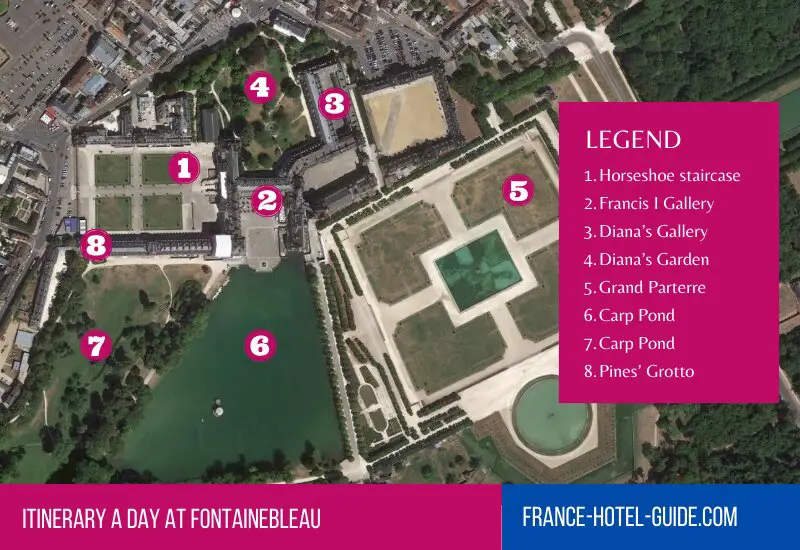
- From the main courtyard of the castle, walk to the Horseshoe Staircase to check out its peculiar architecture.
- Next step: Francis I Gallery, on the castle’s first floor. It would be a shame to miss the Royal’s Elephant painting.
- Now, Diana’s Gallery awaits! Be careful, this library does not lend any of its books.
- Leave the castle’s halls and to the Ovale court, from there you can go up north to reach Diana’s Garden and its famous statue.
- After the wildness of the Huntress, our next stop is the well-ordered Grand Parterre.
- From there, you’ll be able to see the Carp Pond. If you don’t suffer from seasickness, you can do some boating on it.
- After this little boating jaunt, you can take a walk in the English garden close by.
- Following the northern path will lead you back to the main courtyard. On your way, you’ll be able to see the stone giants of the Grotte des Pins.
Guided Tours I Recommend
- Bird’s-eye view of Fontainebleau: Take to the skies and watch Fontainebleau’s castle and its famous forest drift by below you. A 3-hour experience (one hour of flight) piloted by a professional crew. From €260.00 for two adults. (Languages talked: German, English, French, Spanish.)
- Family activities: The video guide available upon request at the welcome desk has recordings tailored to children from 7 to 12 years old. The little tourist train, the horse-drawn carriage rides, and the boating sessions on the Carp Pond are also family-friendly activities.
What to Do if It’s Raining in Fontainebleau?
If it’s raining cats and dogs and you’ve already seen the castle’s halls, one option is to attend Guillaume Dortu’s conferences on the “jeu de paume” or palm game.
It is a ball-and-court game that originated in France and as it happens, Fontainebleau boasts one of the few actual courts designed for it. Here you’ll both be able to play the game and learn about its history.
Information and booking (website in French).
I aim to share my tips and recommendations for the beautiful country of France. My goal is to help you plan your next adventure, whether it’s a weekend getaway or a once-in-a-lifetime trip. From finding the best hotels and restaurants, to discovering unique activities and sights, I’ve got you covered!

